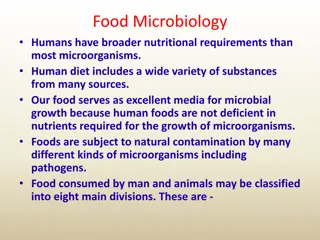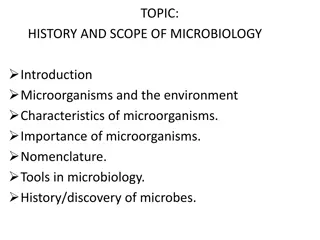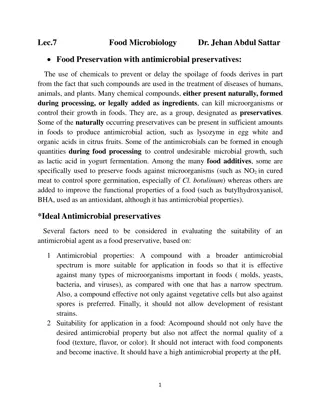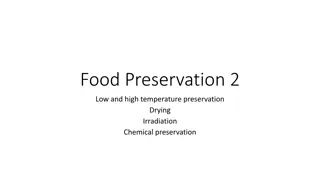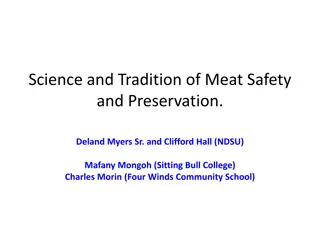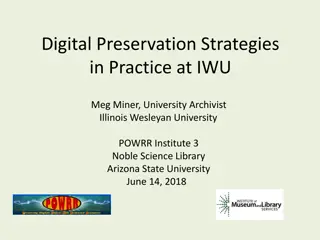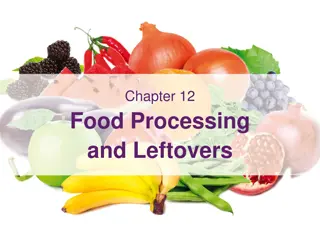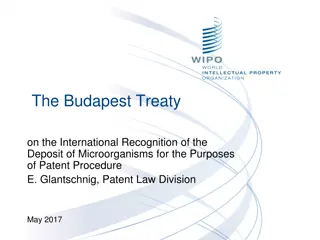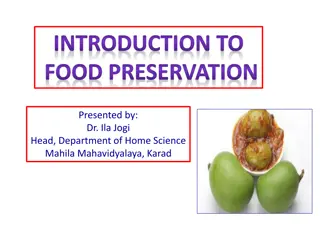Understanding the Effects of High Temperatures on Microorganisms in Food Preservation
High temperatures are utilized to preserve food by affecting microorganisms. Heating can lead to various outcomes such as heat shock, sublethal injury, or cell death in microbial cells and spores. The mechanisms of damage include loss of permeability, denaturation of key components, and inability to repair or multiply. Different heat treatments, such as pasteurization and high-heat processing, target specific microorganisms based on their resistance. Understanding these effects is crucial for ensuring food safety and quality.
Download Presentation

Please find below an Image/Link to download the presentation.
The content on the website is provided AS IS for your information and personal use only. It may not be sold, licensed, or shared on other websites without obtaining consent from the author. Download presentation by click this link. If you encounter any issues during the download, it is possible that the publisher has removed the file from their server.
E N D
Presentation Transcript
The use of high temperatures to preserve food is based on their destructive effects on microorganisms. Depending on the temperature and time of heating, microbial cells and spores can be heat-shocked, sublethally injured, or dead. Heat-shocked cells achieve some resistance to subsequent heating and sublethally injured cells and spores retain the ability to repair and multiply. Heat injury, bacterial cells show loss of permeability and increased sensitivity to some compounds to which they are normally resistant. Sublethally injured cells seem to suffer injury in the cell membrane, cell wall, DNA, ribosomal RNA and some important enzymes (denaturation).Death occurs from damages in some vital functional and structural components. Death of bacterial sporesresults from the inability of a spore either to germinate or to outgrow.
Heat treatments employed in processing foods: 1- Low-Heat Processing or Pasteurization The temperature used for low-heat processing or pasteurization is below 100 C. Pasteurization by use of heat implies either the destruction of all disease-producing organisms (for example, pasteurization of milk) or the destruction or reduction in the number of spoilage organisms in certain foods, as in the pasteurization of vinegar. The pasteurization of milk is achieved by heating as follows: 63 C for 30 minutes (Low Temperature, Long Time [LTLT]) 72 C for 15 seconds ( High Temperature, Short Time [HTST]) These treatments are equivalent and are sufficient to destroy the most heat resistant of the nonspore- forming pathogenic organisms Mycobacterium tuberculosis and Coxiella burnetii.
Milk pasteurization temperatures are sufficient to destroy, in addition, all yeasts, molds, gramnegativebacteria, and many gram positives. The two groups of organisms that survive milk pasteurization are placed into one of two groups: thermodurics and thermophiles. Thermoduric organisms are those that can survive exposure to relatively high temperatures but do not necessarily grow at these temperatures.Ex: The nonsporeforming organisms belong to the genera Streptococcus and Lactobacillus. Thermophilic organisms are those that not only survive relatively high temperaturesbut requirehigh temperatures for theirgrowth and metabolic activities. Ex: The genera Bacillusand Clostridium .
2- High-Heat-Processed Foods The process involves heating foods at or above 100 C for a desired period of time.The temperature and time of heating are selected on the basis of product characteristicsand the specific microorganisms to be destroyed. Low-acid or high-pH (pH > 4.6) products are given treatment to destroy Cl. botulinum spores (the most resistant sporesof a pathogen). However, the products can have viable spores of thermophilicspoilage bacteria (e.g., Bacillus stearothermophilus, B. coagulans, Cl. thermosaccharolyticum,and Desulfotomaculum nigrificans. As long asthe products are stored at or below 30 C, these spores will not germinate. If theproducts are temperature abused to 40 C and above even for a short time, the sporeswill germinate. Subsequent storage at or below 30 C will not prevent outgrowth andmultiplication of these thermophiles to cause food spoilage.
For high-acid or low-pH (pH 4.6) products, such as tomato products, fruit products, and acidified foods, a much lower heat treatment is used. Because Cl. botulinum spores cannot germinate or grow at this low pH. The sporeformers that can germinate and grow in lowpHproducts (e.g., B. coagulans) and the aciduric nonsporeforming bacteria (e.g.,Lactobacillus and Leuconostoc spp.), yeasts, and molds that can grow at low pH arerelatively heat sensitive. These products are generally heated at100 C for a desirableperiod of time. Commercial sterility is also obtained by heating a food at very high temperatures for a short time. This process is designated as ultrahigh temperature (UHT) processing.
Canned foods are sometimes called "commercially sterile" to indicate that no viable organisms can be detected by the usual cultural methods or that the number of survivors is so low as to be of no significance under the conditionsof canning and storage. Also, microorganisms may be present in canned foods that cannot grow in the product by reason of undesirable pH, oxidation-reduction potential (Eh), or temperature of storage. The processing of milk and milk products can be achieved by the use of ultrahigh temperatures (UHT). The UHT treatment include very high temperatures (in the range 140-150 C) and short time (a few seconds) necessary to achieve commercial sterility . UHT-processed milks havehigher consumer acceptability than the conventionally heated pasteurized products, and because they are commercially sterile, they may be storedat room temperatures for up to 8 weeks without flavor changes.
*FACTORS AFFECTING HEAT RESISTANCE IN MICROORGANISMS Equal numbers of bacteria placed in physiologicsaline and nutrient broth at the same pHare not destroyed with the same ease by heat. Some 12 factors or parameters of microorganismsand their environment have been studiedfor their effects on heat destruction, and are presented below. 1-Water The heat resistance of microbial cells increases with decreasing humidity, moisture, or water activity (aw).Dried microbial cells placed into test tubes andthen heated in a water bath are moreheat resistant than moist cells of the same type. 2- Fat In the presence of fats, there is a general increasein the heat resistance of some microorganisms(Table 1).This is sometimes referredto as fat protection and is presumed to increaseheat resistance by directly affecting cell moisture.
Medium Thermal Death Point (0C) Cream Whole milk Skim milk Whey Bouillon (broth) 73 69 Note: Heating time: 10 minutes 65 63 61 Table 1:The Effect of the Medium on theThermal Death Point of Escherichia coli
3-Salts The effect of salt on the heat resistance ofmicroorganisms is variable and dependent on thekind of salt, concentration and otherfactors. Some salts have a protective effect onmicroorganisms, and others tend to make cellsmore heat sensitive. It has been suggested thatsome salts may decrease water activity andthereby increase heat resistance by a mechanism similar to that of drying, whereas others mayincrease water activity (e.g., Ca2+ and Mg2+) and,consequently, increase sensitivity to heat. It has been shown that supplementation of the growthmedium of Bacillus megaterium spores withCaCl2yields spores with increased heat resistance,whereas increased phosphate content decreases heat resistance. 4-Carbohydrates The presence of sugars causes an increase in the heat resistanceof microorganisms suspended. Thiseffect is at least in part due to the decrease inwater activity caused by high concentrations of sugars.
5-Proteins Proteins in the heating have a protectiveeffect on microorganisms. Consequently,high-protein- content foods must be heat processedto a greater degree than low-protein-contentfoods in order to achieve the same end results. 6-pH Microorganisms are most resistant to heat attheir optimum pH of growth, which is generallyabout 7.0. As the pH is lowered or raised fromthis optimum value, there is a consequent increase in heat sensitivity. Advantage is taken of this fact in the heat processing of high-acid foods, whereless heat is applied to achieve sterilizationcompared to foods at or near neutrality. 7-Numbers of Organisms The larger number of organisms, the higherdegree of heat resistance (Table 2). Ithas been suggested that the mechanism of heatprotection by large microbial populations is dueto the production of protective substances excreted by the cells. Because proteins are known to offer some protection against heat, many of the extracellular compounds in a culture would be expectedto be protein in nature and, consequently,capable of affording some protection.
Number of Spores Thermal Death Time(min) 72,000,000,000 1,640,000,000 32,000,000 650,000 16,400 328 240 125 110 85 50 40 Table 2:Effect of Number of Spores ofClostridium botulinum on Thermal Death Time at 100 C
8-Age of Organisms Bacterial cells tend to be most resistant to heatwhile in the stationary phase of growth and less resistant during the logarithmic phase.Heat resistancehas been reported to be high also at thebeginning of the lag phase but decreases to aminimum as the cells enter the log phase. Oldbacterial spores are reported to be more heat resistantthan young spores. 9-Growth Temperature The heat resistance of microorganisms tendsto increase as the temperature of incubation increases,and this is especially true for sporeformers.Ex:cultures of microorganisms grown at 44 C was foundto be approximately three times more resistantthan cultures grown at 35 C .
10-Inhibitory Compounds A decrease in heat resistance of most microorganismsoccurs when heating takes place inthe presence of heat-resistant antibiotics, SO2,and other microbial inhibitors. The use of heatplus antibiotics and heat plus nitrite has been found to be more effective in controlling the spoilage of foods than either alone. The practical effectof adding inhibitors to foods prior to heattreatment is to reduce the amount of heat thatwould be necessary if used alone . 11-Time and Temperature The longer the time ofheating, the greater the killing effect of heat. Thehigher the temperature, the greater the killingeffect of heat. As temperature increases, timenecessary to achieve the same effect decreases.Also important is the size of the heatingvessel or container and its composition (glass,metal, plastic). It takes longer to effect pasteurizationor sterilization in large containers than insmaller ones, and containers withwalls that do not conduct heat as readily as others. 12-Effect of Ultrasonics The exposure of bacterial endospores to ultrasonictreatments just before or during heatingresults in a lowering of spore heat resistance.
*Thermal Destruction of Microorganisms: -Thermal Death Time (TDT) Thermal Death Time (TDT) is the time necessary to kill a specific number of microbial cells or spores at a specific temperature. By this method , the temperature is kept constant and the time necessary to kill all cells is determined. -Thermal Death Point (TDP): Temperature required to kill agiven number of microorganisms in afixed time, usually 10 minutes. Here temperature is unknown.
- Decimal Reduction Time (D Value) The D value is the time in minutes required to destroy 90% or 1 logof microorganisms. Ex: The 12D concept is used in heat processing of high-pH foods (pH > 4.6, lowacidfoods such as corn, beans, and meat) to destroy the most heat-resistant sporesof the pathogenic bacteria Clostridium botulinum. It means that the products aregiven heat treatment to reduce the population of Cl. botulinum spores by 12 log cycles. The12D value at D121.1 C is ca. 2.8 or ca. 3.0 min.
-Z Value The Z value, which indicates thetemperature ( C or F) required to change the D value (or TDT) to transverse by 1log. A value of Z = 10 in C implies that if the D value of bacterial spores at 100 Cis 50 min, at 110 C it will be 5 min, and at 120 C it will be 0.5 min. In developingheat-processing conditions of a food, D and Z values are used to obtain desirable destruction of microorganisms (cells and spores). -F Value The Fvalue is usedto express the time (min) necessary to completely destroy a specific number ofmicrobial spores or vegetative cells at a temperature (121.1 C for spores and 60 Cfor vegetative cells).
F0= D( log a- log b) a: the number of cells in the initial population b: the number of cells in the final population





